Wide Angle Orthostereo
by Eric Howlett – February 1990
International Society for Optical Engineering Proceedings
Abstract
Angular fields of view filling at least the region directly viewable on the optical axis of the eyes — about 90° — are necessary to support the illusion of being immersed in another space, be it computer generated or the product of remote cameras. Any greater view, up to 270° laterally, enhances the illusion. Stereopsis, and completing the 360 visual sphere by head motion, round out the illusion; they require the wearing of a head-mounted-display (HMD). This paper describes the optical viewing system used in almost all existing HMD systems, and makes the case that, compared to video monitors, these HMD systems provide a qualitatively different kind of access to remote or computer generated reality — a difference that, even in the present crude state of the art, is striking enough to herald a new order of computer interfacing and real time telepresence. A caveat is presented: that if the spatial presentation is false — not "orthospace" — then the charm and power of the illusion, and the utility of the system, are sharply diminished.
2. THE GOSPEL OF WIDE ANGLE ORTHOSTEREO
Very high-resolution monitors and high-density television have generated a great deal of enthusiasm. They are certainly significant technological and aesthetic steps forward, but it is one of our purposes here to emphasize that, in all their glory, they provide only a very narrow view of the world. Even a magnificent screen 5 feet wide will normally offer only about a 50° view because very few people will sit closer to it than 5 feet away. This limitation is overcome by the use of HMD's; benefits are derived from increases in the field of view even up to 270° without head motion. The complete realization of wide-angle orthostereo includes means for sensing the direction in which the head is pointed, so that the 270° field can be properly presented no matter which way the orthospace adventurer is facing. It is mandatory that "things" be presented in their "true" direction and shape.
2.1. Definitions
We shall take as the minimum for a system qualifying as "wide angle" to be a direct visual field of 90° , an amount that includes the entire region over which the normal eyes can swivel, and that also eliminates the stereo window inherent in systems with a narrower field of view.
A simple and sufficient definition of "orthoscopy" is that all points of the scene as viewed are at the same azimuth and elevation as they were in the original scene. "Orthoscopic stereo," or "orthostereo" simply demands that the two images seen by the two eyes meet that same standard simultaneously. While it suffices to say that all angles of sight are duplicated, the most observable fact is that the remote or database environment — the "otherworld" — is seen with straight lines straight and perspective correct in every direction — a condition stipulated by the term "orthospace," which comprises varied scaling, normally life-size, but alterable to achieve oversize or miniature modeling by altering the spacing of the camera lenses, or the spacing of the two viewpoints in the database.
2.2. Cyberspace — the power of the illusion
As the term seems increasingly to be used, "cyberspace" denotes a stereoscopic presentation having two primary characteristics: 1) interaction between the actor and the surroundings in a remote or virtual space and, 2) a very wide angle of view, permitting the actor the illusion of being inside the space looking out, rather than outside looking in.
The power of the illusion of being in a remote or artificial environment is suggested by the fact that the extremely poor definition possible with presently available LCD displays, and the relatively low screen refresh rate of which present computer systems are capable, do little to destroy the involvement of anyone trying out these systems. The user (traveler, actor) seems ready to consent to an agreement with the devil in which he or she will ignore the poor resolution, much of the system lag, the monochrome display in the widest angle systems, and the limited field of view in the present color systems, for the privilege of continuing to enjoy the cyberspace romp.
2.3. Other benefits of wide angle orthostereo
2.3.1. Enhances subjective "presence"
The Author's first hint of the benefits of wide-angle stereo came in a retail photographic shop in 1946. On the counter was a Stereo Realist display; he looked in, as such displays always invite one to do; there was a nude stretched out in a private idyll on some sand dunes! The sense of presence is clear from the author's reaction, which was to back away immediately and furtively look around, just as if, in fact, he had accidentally walked over the top of a sand dune and seen the apparition. A companion looked into the viewer and did exactly the same thing.
That view however, while stereoscopic, was not by any means wide, and thirty years mulling over the greatly improved intimacy that might be achieved with a much wider view eventuated in the LEEP System and in this paper. When an image can be seen life size and close up — possible with portraits only if you have wide-angle orthostereo — the "presence" is not equalled by any visual experience other than being there.
2.3.2. Eliminates the "window"
In the course of working with the "LEEP" system we have come to think of the experience of wide-angle orthostereo "as stepping through the window." It is characteristic of all previous stereoscopic systems that the left eye view and the right eye view are separately circumscribed by frames that, because vertical edges of the frames are simultaneously visible with both eyes, are fixed in space by the angle of convergence required to fuse them. The result is an apparent "window" somewhere in space. Only if the window is made so large that the vertical edges cannot simultaneously be seen, and merged, will the need to conceptually deal with, and locate in space, a "window" that is not actually there, cease to be a matter of concern. And only when this window is eliminated (requiring an angular field of about 90 ) will the sense of being inside the space, looking out, become convincing.
2.3.3. Increases safety and efficiency
Imagine a situation in which a very wide angle field, not necessarily having high definition, is of great importance. An extra-vehicular activity is required outside an orbiting satellite. It requires the use of tools, and even if the tools are tethered, it is very much faster to retrieve a tool that one has "parked" in space if the location of the tool is clear in the peripheral field. If one has either to reel in a tether, or to search by scanning a narrow field of view, operations are made much more difficult, and difficulty can sometimes be equated with impossibility. Consider safety. (See Appendix 8.2) Objects such as protruding solar panels can be damaged, and booms and wings not perceived in the peripheral field can cause injury or damage to a space suit. Safety from underwater predators, and the ability to navigate in enclosed underwater environments, such as wrecks, are greatly enhanced by an extended peripheral field.
2.3.4. Gives a peripheral "anchor"
Accurate self-orientation in the otherworld in which one is acting is what we mean by the peripheral "anchor." It requires that the otherworld wrap around the visual field sufficiently to define distance. Peripheral resolution does not have to be particularly high, but the perceived direction of objects has to be accurate, as does the size of the space relative to the spacing of the eyes of the actor. The peripheral anchor is important in permitting the actor to move confidently without constantly scanning the environment. Picking up a wrench that has been "parked" in space can be done altogether in the peripheral field while keeping one's eyes on the task at hand. It should be noted that if the space is not orthoscopic however, the proprioceptively guided grab for the wrench will miss. If objects are not located correctly in the peripheral field, then when the head turns toward them they will seem to move to a new location and, as is the case with distorted fields in some video systems, the result is a considerable anxiety, a slow closing on a target object, and also an apparent time lag.
2.4. The quantification problem — information and detail
It doesn't make much sense to extoll the benefits of wide angle orthostereo without any mention of the cost. Similarly, the cost cannot be gauged simply by multiplying the solid angle of a narrow field of view system by the factor of the increase of the solid angle of a very wide view system, because the resolution required is not the same at every point. Apart from the well known fact that the eye has very much higher resolution near the fovea, resolution that drops off very rapidly with angle away from the central part of the field, it is also true that for operational purposes far less resolution is required in the periphery. To see this it helps to distinguish among the terms "information," "sharpness" or "detail," and "importance" or "significance." Perhaps it is sufficient here to mention that, in an undersea environment, it will involve about the same amount of information to convey to the actor that a grouper is off his right shoulder as it does if the fish happens to be a shark, assuming equal local populations. The importance of the two approximately equal pieces of information however is far different. Furthermore, once the detail is great enough to distinguish between a grouper and a shark, added detail makes very little difference. In fact in a cost/benefit analysis it may very well be decided that the only thing important is to know that something is there, so that the actor can look and see what it is. For a great many situations we feel, as a rough and ready rule, that the central 30° of the visual field probably deserves about as much information as the entire remaining 180° of a hemispherical world. By "information" in this statement, we mean the channel capacity, or storage capacity, devoted to the areas in question. This rule may be thought of as an attempt to apportion the importance of the visual data fairly between central and peripheral areas. This complex matter needs more attention.
2.5. The viewing surface problem
2.5.1. Distortion — to record the not-flat world
It is important to distinguish clearly between "viewing error" and "distortion." False perspectives, commonly called by photographers "telephoto" or "wide-angle" distortion are certainly to be avoided, but they are viewing errors, and not distortion, properly speaking. If a photograph is viewed from too close or too far away it will suffer from this so-called distortion. One advantage of HMD's is that the fixed relationship of the eyes and the optics precludes viewing errors arising from improper user viewpoint.
2.5.2. A five-foot print?
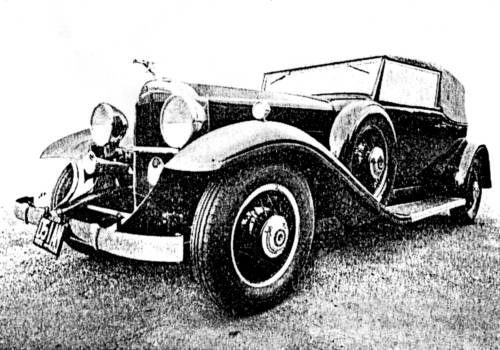
Figure 1 A wide angle, but undistorted photograph. (Source: Hardy and Perrin) Correct viewing distance: three inches. [For correct on-screen viewing, the distance from the center of your eyeball to the screen should be half the width of the picture (2006)]
If the touring car (Figure 1) were to be printed in such a way that the perspective would be correct in an ordinary studio situation, it would have to be about 5 feet wide and viewed from about 2-1/2 feet. Even in the studio these conditions usually fail because the prints are hardly ever that big and people tend to stand farther than 2-1/2 feet away. Clearly, flat viewing surfaces are not very practical for wide angle worlds recorded by linear projection on a flat image plane (below).
Actual distortion is required; it involves the process of bending lines that are straight in the original object space. Distortion is certainly necessary, for example, if a 180° field of view, or even something approaching it, is to be contained on a flat plane, as it must be in order to appear in most video systems. In the case of the LEEP system, a very wide field of view is warped onto a plane surface by a fisheye-like transformation. Of course this transformation must be undone and the correct angles of view restored if the space is to be correctly rendered for the person viewing, who, we then say, sees an "orthospace."
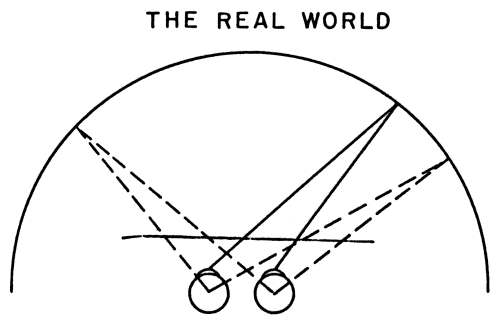
Figure 2 Linear Projection
2.5.3. Ceiling corner projection
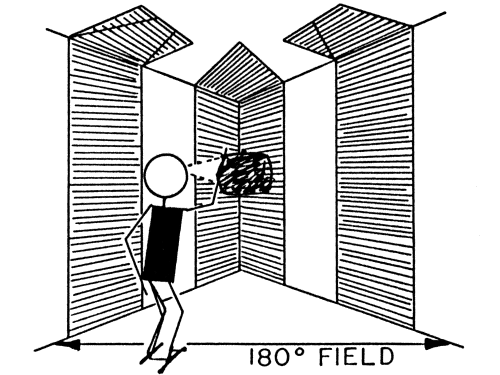
Figure 3 Corner Projection
Figure 3 shows what might be done by painting a scene in the corner of a room. The little stick figure is viewing tall buildings that occupy almost 180° of his lateral field of view. When a person stands at the exact spot for correct perspective, simple painted block shapes can create a startling illusion of reality; there is no need for any trompe l'oeille artistry. None of the illusion would be presented, however, if the scene were limited to the little video monitor suggested as a black form, no matter how high the resolution of the monitor.
2.5.4. The OMNIMAX dome
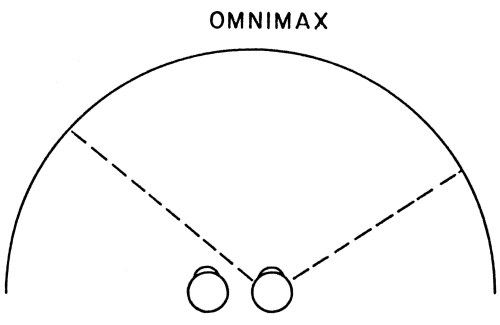
Figure 4 OMNIMAX Dome
An almost hemispherical dome, such as that used by IMAX for display of very wide angle movies in the OMNIMAX theatres (Figure 4) does answer the needs of an audience for very wide angle imagery, but it does not provide for good stereoscopy or, of course, permit interaction with a remote or computer based environment.
2.5.5. Video screens (Figure 5)
If provided large enough and in sufficient numbers, as is done by Evans and Sutherland for their flight simulation systems, video screens can give spectacular wide angle, though in existing configurations there is no stereoscopy. In principal, using shuttered eyeglasses, true stereo could be introduced, but the basic system cost is such that its widespread application for individual use is not to be anticipated. The figure suggests that a great many screens and channels of video information are required, and this is indeed the case.
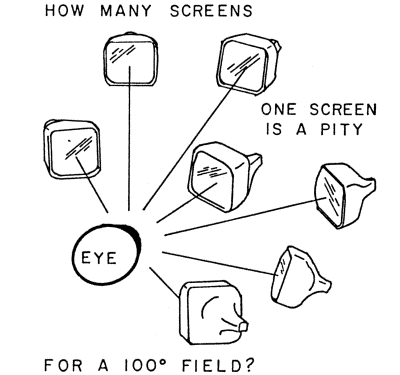
Figure 5 Video Screens
3. THE GEOMETRY OF WIDE ANGLE ORTHOSTEREO
3.1. The field of the eye
A rational approach to the problem of presenting wide-angle orthostereo starts with an understanding of the capacity of the human eye. It is well known that the human eye is capable of its highest resolution only within a degree or so of the optical axis — the foveal region of the retina. It is less well known that the useful peripheral field of the human eye is extremely wide. Without rotation, the normal eye can perceive motion and presences — often signaling danger — as much as 90° off axis. This represents a 180° lateral field, even without rotation of the eyeball. Adding to this the approximate 90° azimuthal rotation of which the normal eye is capable, and it is seen that, without head motion, the human optical system is actually capable of important perceptions over a 270° lateral field. HMD's are not likely to provide for the entire 270° field, at least in the near future. Experience shows that a 90° direct field of view, that is to say an eye lens whose diameter is twice the distance from its apex to the center of the eyeball, provides an excellent sense of immersion in cyberspace so long as somewhat more than 90° is available behind the eye lens perimeter.
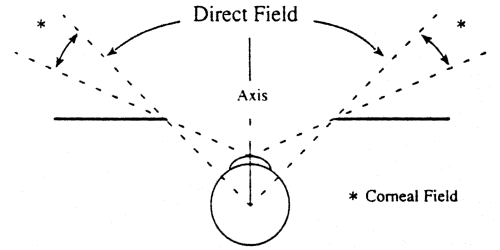
Figure 6 The Direct Field
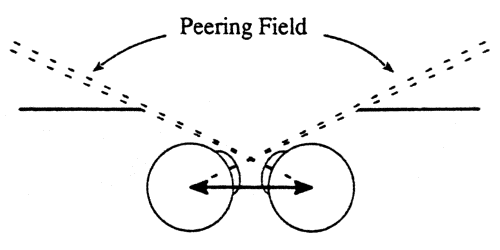
Figure 7 The Peering Field
3.2. The corneal field "knothole effect"
When using an HMD with an eye lens diameter twice the eye center to apex distance, (Figure 6), one finds that, by looking straight ahead, a much greater field is observed than can be viewed by swiveling the eye directly to the edge of the lens. This is the result of refraction at the surface of the cornea, as illustrated in the figure, and it is an important ingredient of realistic immersion in a cyberspace when using an HMD, even though "peering" (Figure 7) is not possible.
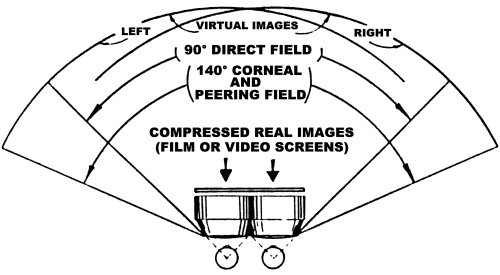
Figure 8 Expansion of the LCD images into a stereoscopic "Virtual World."
3.3 The virtual screen — LEEP optics
Figure 8 shows a top view of the LEEP optical system with the two eyes of the user and the co-planar screens at the focus of the optics. By means of this system each eye is treated to a large apparent image that may be thought of as one OMNIMAX screen for each eye. Of course with presently available LCD's the imagery is not so sharp as a photograph.
4. THE REALIZATION OF WIDE ANGLE ORTHOSTEREO
4.1. Three field compression paradigms
In wide angle orthostereo the real world (or its computer generated equivalent — cyberspace) must be mapped onto a plane in order to make it possible to store it in an x-y array or transmit it as a video signal. Three mapping possibilities are illustrated below.
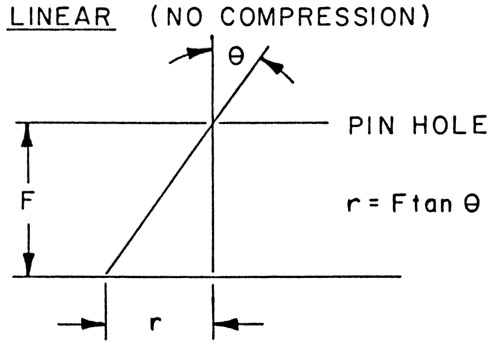
Figure 9 No Compression
Figure 9 shows a linear projection of the real world angles onto an image plane at the bottom. This is how a pin hole camera, or an ordinary camera with distortion-free lens, turns the 3-dimensional world into a flat image. Clearly it is inappropriate for orthospace purposes because of the great expenditure of image storage space (and therefore of channel capacity) for the peripheral field.
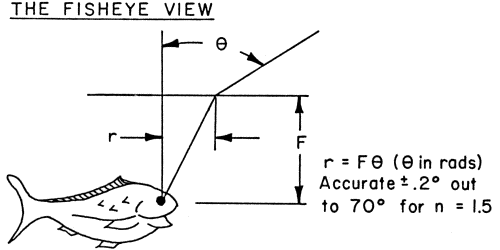
Figure 10 Fish-Eye View
Figure 10 shows the classic fish-eye view, which is often implemented in photographic camera lenses for acquiring very wide views. The result may be seen as somewhat eccentric because there is almost never any attempt made to restore the original orthoscopic space. The mapping formula involved is so simple, however, the radius on the flat image being proportional to the angle in object space, with the constant of proportionality being the lens focal length, that it serves as a useful standard.
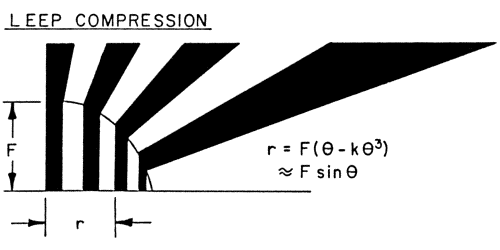
Figure 11 LEEP Compression
Figure 11 makes graphic the LEEP compression, which makes a fish-eye-like image out of the real world from 70° left to 70° right in the camera lenses. The mapping formula, which must be considered in performing the expansion algorithmically, is shown to be very close to the first two terms of the power series expansion of the sine of the object space angle.
4.2 LEEPvideo System I
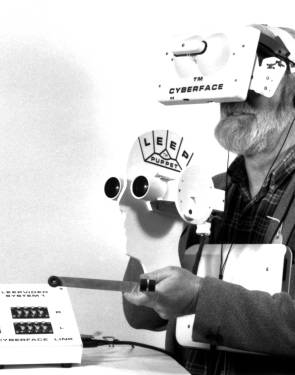
Figure 12
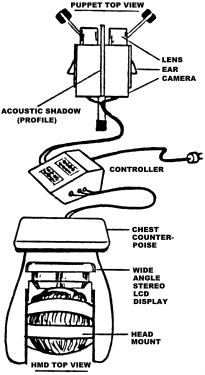
Figure 13
The system is shown as it might be tried out immediately after unpacking. Except for certain systems that have been put together by the workers at NASA Ames System Research Center over the years, this is the only LCD-based system that provides true orthospace, and it is the widest angle system available. It is being produced in small batches, primarily for an assortment of applications and research in government and industrial laboratories. The LEEPvideo System I makes it possible to explore the remarkable properties of wide angle orthostereo with a nominal investment and without depending on any other facilities, as it is a plug-in, standalone system.
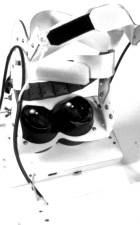
Figure 14
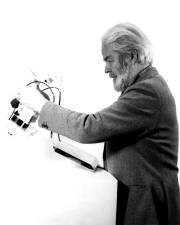
Figure 15
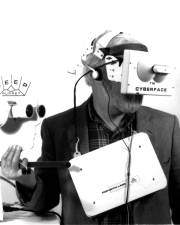
Figure 16
The most notable feature of the system, other than the fact that it is readily available on a commercial basis, is the novel method of mounting the display on the head. Note the large white "chest counterpoise," which serves as a terminus both for the main cable to the HMD, and for the distribution cables up to the left and right eyes, and as a highly damped counterweight to the display itself. The counterpoise can remove all of the two pound weight of the display from the face proper, transferring it to the soft nylon straps across the top of the head. We call it the Feathermount " because by this means the weight of the head mount is supported directly above the spine — a method that water carriers have shown for centuries to be very easy. This head mount may be worn for hours without discomfort. The chest-mounted counterpoise also has the advantage that it does not add to the inertia of the the head mount, which, if it were a conventional counterweight located at the back of the head, would add uncomfortable twists during rapid turning movements. In this system when the head turns, the chest counterpoise simply rotates on the chest, as seen in Figure 16.
4.3. The LEEPvideo stereoscopic viewer optics
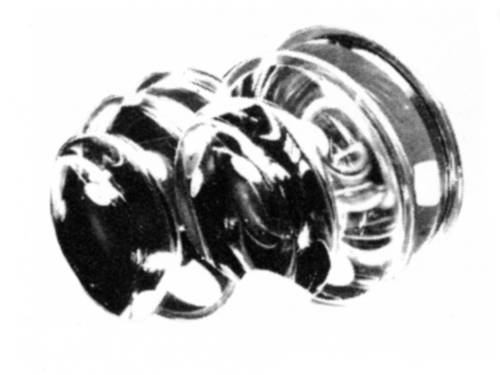
Figure 17 Six Large Elements
The basic optical system used by NASA and essentially all the investigators and industrial players in the "Artificial Reality Industry," as well as owners of LEEPvideo systems, has three large lens elements per eye with focal length of 38mm and entrance pupil diameter of 60mm. The lenses are mounted in a black, vacuum-formed ABS housing for lightness, and are cut away for nose-bridge and brow-ridge clearance. A demonstration version with diffusing screen and six LEEP slides is pictured in Figure 18.
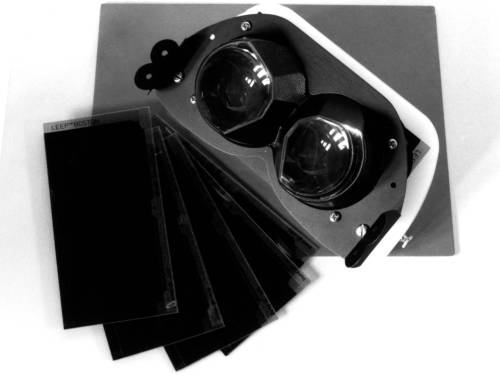
Figure 18 LEEP Demonstrator
4.3.1. Interaxial spacing: 64 millimeters
For viewing comfort when shifting from near to distant subjects, it is recommended that the infinity point conjugate spacing of the images in the viewing plane be 62 mm. It is important to note that this image spacing is not determined by the interpupillary distance of any particular person using the viewer, but rather by the requirement that nobody be required to cause their left and right visual axes to diverge, which causes severe eyestrain, and which everybody would have to do to merge an infinite image pair if the spacing exceeded 64 mm. In practice, a slight convergence for infinitely distant subjects is preferable, which accounts (along with a margin for system error) for the 2 mm closer spacing recommended for the stereo pair of images.
4.3.2. Field of view
This is a wiggly parameter. The following remarks presuppose that a properly scaled image in the LEEP compressed format is present at the focal plane of the viewer. A 140 degree field is possible if the eyes can move laterally with respect to the viewer — "peer about" through the hole represented by the eye lens perimeter. In a head-mounted display, however, the eyeballs normally are constrained to rotation in azimuth and elevation about their centers. Accordingly the direct field is limited by the eye lens perimeter (which is also the entrance pupil and the field stop) and by the proximity of the eye to the apex of the eye lens. Most eyes can swivel only about 90 degrees, and it is easy for most people to get close enough to see this much, though eyeglasses may impose an added limit. The significant number is thus the eye lens entrance pupil radius of 30mm. If the center of rotation of the eyeball is 30mm away from the center of the entrance pupil, the directly viewed field is then (from the geometry) 90 degrees. (Actually, refraction at the cornea gives a sensibly wider field, the "corneal field," when looking straight ahead — the "knothole" effect, Figure 6.) The geometry gives us several more numbers: if 1/2" of lateral head motion is allowed each way, the direct field is 110 degrees; if the eyeball center of rotation is brought to (a possible) 20mm, the direct field is 112 degrees; if both motions are allowed, the direct field is 130 degrees.
4.3.3. Lateral chromatism
Called also, and more descriptively, "chromatic difference of magnification" this aberration is normally observed as blue and red "fringes" at the extremes of the field of an optical system. In the interest of achieving high magnification and a wide field in the same design, no attempt was made to achromatize individual elements in the LEEP optics. In fact the basic LEEP invention consists mainly in compensating the viewer chromatism by an opposite chromatism in the image viewed. LEEPvideo System I (and NASA) avoid the need to correct the chromatism by using a monochromatic display. [This sentence is incorrect. It should read to this effect: "Leepvideo System I (and NASA) cannot correct the chromatism of the magnifiers because the displays use monochromatic LCDs. However, because the LCDs are smaller than the full field of the magnifier, the extreme chromatism at the edges of the lenses is not visible." (2006)] Adequate electronic compensation can be accomplished by making the red image about 1% larger (linearly) than the blue image, with the green in between. LEEPvideo camera lenses provide a color compensated image when used with a color video camera.4.3.4. Field decompression algorithum
In order to make the best possible use of the video channel bandwidth, most of the image area is devoted to the central field, and the peripheral field is compressed into the edges of the image. The result is an extreme "fisheye-like" image, in which the radial distance from the image center is approximately proportional to the sine of the real, or the computer-generated, object-space angle. To expand this image, i.e., to restore the orthoscopy of the space (orthospace) the viewer optics must have a very large positive radial distortion. This distortion is defined approximately by
R = F (A - .12 A^3 ) [The coefficient of the second term has since been found to be closer to .18 (2006)]
Where: R is the radial distance from the optical axis to a point on the (nominal) focal plane of the viewer, F is the axial focal length and A is the apparent off-axis angle in radians of the image of the same point, as seen by a person using the viewer. (Or, to say it differently, A is the angle of the collimated beam the optics produce from light emanating from the point in question.)
5. CURRENT AND IMPROPER ARRANGEMENTS
Of the many wide-angle stereoscopic video systems operating, the only ones, to our knowledge, that implement true orthostereo are those at NASA Ames Research Center, and those being operated by owners of the LEEPvideo System 1. )
Other applications of the LEEP optics, as of this writing, make no provision for orthoscopy in the image presentation. Some groups seem to feel that the added computational burden of rectifying the space does not justify the gain because it slows down the rate of which the images can be recalculated — leading to other problems. This argument is plausible because the systems provide a somewhat narrow field of view — usually using a 3" diagonal LCD rather than 4", so the loss occasioned by a lack of orthoscopy at the edges of the scene is not so dramatic. We feel however that the losses have not been accurately quantified. In particular, the instability of the peripheral anchor occasioned by the apparent movement of the peripheral objects when the actor's head turns, must have deleterious results. Our own observations suggest that this instability of the peripheral field leads to an apparent increase in the computational (or head sensing) delay, which is one of the problems that is on the top of every user's mind. One way to solve this problem in a cyberspace system, without adding to the computational load, is to present linear images on two monitors, which are then viewed by cameras with LEEPvideo lenses. This is the recent approach of the investigators at NASA Ames and, in the words of Scott Fisher, "It makes a world of difference!".
In the case of remote environments, viewed by a pair of cameras, all that is required is the correct pair of LEEPvideo camera lenses for orthoscopic rendering of the scene.
6. WHAT IS NEXT?
The two greatest limits to the widespread commercialization of cyberspace are the enormous computational load imposed by the need for rapid recalculation of complex spaces, and the resolution limits imposed by currently available LCD's. The first problem seems destined by the potential for greater computational power, and by market forces, to become the lesser of the two problems. A ten-fold increase in computational power over what is now available from high-end microcomputers with add-on display boards, would more than remove the computer from its role as limiting factor. Such an increase in power can be anticipated soon, if it is not already here. A similar increase in the available detail of an LCD display, however, is neither planned or projected, to our knowledge. A 100-fold increase in the number of pixels in each of the two displays is clearly an immediately desirable goal, but it is not even clear that it is technically feasible in the long range. The market is not asking for sufficient numbers of such a device to justify the very large investment that would be required to develop it.
Accordingly (even if the prevailing technology turns out to be other than LCD-based) we believe that the industry will be built around dual resolution systems, also known as "area of interest" displays. Such displays can capitalize on the fact that the peripheral field requires very much less detail than the central field and yet preserve the value inherent in the extremely high resolution of which the eye is capable very near its axis. A number of configurations are possible, including combinations of black and white and color, high resolution inserts that are fixed in the center of the field or inserts variable as to size (resolution) and location (according to the direction of the axis of the eye).
In a cyberspace system, where the otherworld resides in a computer database, it is not clear how the computational and storage load is affected by the requirement for a high-resolution insert. Much depends on the architecture of the space and the design of sophisticated display lists.
When the otherworld is a remote space observed by cameras, it is possible to provide high-resolution inserts in a much more straightforward way. If the space is dissected optically at the camera, so that a wide angle signal and a narrow-angle, high-resolution signal is provided for each eye, giving a total of four video channels, then the imagery can be transmitted and reconstructed in an appropriate HMD (also by optical means) so that the storage and bandwidth requirements are always just twice those for a wide-angle orthostereo display without the insert. (NTSC channels can be used.) LEEP SYSTEMS / POP-OPTIX LABS is making available a desktop monocular feasibility system for evaluating these questions to the extent that a fixed insert can provide the answers.
We are proposing also to provide a dual-resolution system that is stereoscopic and dynamic in the sense that the insert will vary in both size (resolution) and location.
7. ACKNOWLEDGMENTS
We wish to make a special acknowledgment of the vision and gracious support of Michael McGreevy and Scott Fischer and their associates at the NASA Ames Research Center. Since 1985 when NASA Ames first used the LEEP Optics in conjunction with liquid crystal displays to provide an LCD-based virtual reality, many other laboratories and organizations have followed suit, all of which have used our optics. At their many demonstrations of the systems, both at Ames and during the delivery of talks and papers in other locations, they have acknowledged our Pop-Optical contribution in a way that has greatly magnified our efforts to interest people in a very wide view of the world.
Not until Nathaniel Durlach and Xio Dong Pang of the Sensory Communiction Group of the Research Laboratory of Electronics at M.I.T. and the Biomedical Engineering Department at B.U., as well as NASA, wanted LEEP lenses for video cameras, were we finally nudged into video system technology.
8. APPENDIXES
8.1 Letter to a friend
Our telephone conversation yesterday had a startling consequence.
I was mulling over your observations that people had no trouble ignoring their eyeglass frames and that loss of peripheral field was discovered in persons who did not complain of it, and I supposed that ignoring the frames is quite a different matter from ignoring the field outside the frames, and that adjusting to the slow loss of peripheral field is quite a different matter from the sudden onset of the handicap.
A simple experiment would illuminate both suppositions: I would occlude my own field outside my glasses frame with masking tape and see what happened. I got quite a fright — but let me tell it in sequence.
The first supposition was confirmed instantly: occlusion of the extra-frame field is vastly more difficult to ignore than the frames themselves. I did it readily when discussing lenses on a table, and instructing someone in assembly techniques, but as soon as I had to move myself around \i was another story. My frames are not small, being 56mm clear glass in the largest dimension and 44.7mm by 50.0mm at the vertical and horizontal through the center of vision — providing almost the field of the LEEP viewer. Yet I had the sense of bumbling about, always wary of tripping or running into a post or a bookcase, and needing constantly to swing my head from side to side to avoid doing so. Descending stairs was a decidedly conscious process, with a constant bobbing of the head required to stay in adequate "touch" with my surrounds. Clearly, as to the second supposition, adaptation, while no doubt possible, was not a trivial process and could palliate, but not eliminate, the handicap. That is was indeed a handicap was dramatized during a short drive.
Backing out of a parking place with occluded extra-frame field was unpleasant (and required a limber neck) and the head-swinging when I entered an intersection seemed absurd. I decided it was really risky and just to go around the block and back to the parking lot. It happened at the second left turn.
It seemed to be in the back seat of the car — a motorcycle gunned to about 12,000 rpm — it could have been on the roof, the way it sounded! But by the time I could scan the scene, it was gone! / never saw ihal rnolorcyde!! A chill ran from my medulla to my solar plexus. I crept back to the lot and tore off the tape.
And the good whole world came back; it was just as if two lost screens in a three screen theatre were restored. I hadn't missed them anywhere near so much as I appreciated them now!
I can hardly recommend this experiment, but even in gedanken form, or anecdote, it may serve to confirm the importance of the peripheral field — at least when the subject is acting bodily in the remote or artificial situation. The LEEP system is not yet wide enough. Resolution (in the periphery) is not the problem — all you need to be able to do is perceive motion, or a presence, to feel safe and THERE. A 180 degree field would be damn nice!
8.2 Brief glossary
Actor An Otherworld q.v., traveler who is able to effect changes in the Otherworld.
Artificial Reality The oxymoron on the table. Stereoscopic, interactive, database-based worlds displayed with such a wide field of view that the actor is on the inside looking out, as opposed to being on the outside looking in, as with conventional monitors, no matter how large the screen. See Virtual Reality. See Cyberspace.
AR Demo Set A A one time only demonstration viewer-diffuser with six LEEP slides—to give a taste of Orthospace drama.
ARV-1 Model designation of the de-facto standard viewing system optics for the A-R industry. Made by LEEP SYSTEMS / POP-OPTIX LABS.
Binaural Like stereo sound but recorded with two microphones in the ear canals of a dummy head with pinnae g.v., and listened to only with headphones. Eerie effect of being there.
Corneal Field Coined by us to denote regions of the visual field that are "behind the edge" of the entrance pupil of an HMD lens system, but which can be perceived if the eye axis is aligned with the optical axis of the lens system. Refraction at the cornea surface provides a vantage point about 1/2 inch closer to the eye lens than the center of the eyeball, hence a wider cone of view. See Peering Field.
Cyberface Our coinage and trademark for what we mount on your face to interface with Cyberspace.
Cybernetics Coined by Professor Norbert Wiener for his book of that title in 1948. From the Greek for steersman, he defined it in a subtitle as "control and communication in the animal and the machine." He would have become dyspeptic at some of the uses of his word in the last forty years, but not, we think, with Cyberspace. He would note however, that the loop has to be closed, that it isn't cyber-anything if the actor can't interact with the space.
Cybersee also Cybersight. Listed for its euphony. Cybersound See Cybersee.
Cyberspace Coined by William Gibson in his prescient novel, Neuromancer. Probably an Autodesk trademark. See Otherworlds. See Artificial Reality. See Virtual Reality.
Field of View (FOV) A complexity. Of the eye itself we speak of the direct field — the solid cone swept out by the axis of the eye as it rotates in its socket, usually about 90 degrees except where the nose and the brows interfere, and the peripheral field — everything beyond, perceivable because of the refraction at the cornea, usually about 270 degrees laterally for healthy eyes. For the limitation of the field by optical systems, See Corneal Field and Peering Field.
HMD Acronym for Head-Mounted-Display. (See our Feathermount ) A viewing system that mounts on, and turns with, the head. Should provide an image filling at least the direct field of view q.v., an image that changes according to the head movement of the wearer so the surroundings appear stationary.
Knothole Effect In which you can see more if you don't look directly. See corneal field.
LEEP Compression The compression in the LEEP system of the angle of view in object space (Cyberspace) to a radial distance on a flat medium approximately proportional to the sine of the angle. Permits economy in data storage and channel capacity.
LEEP The acronym (post facto) for Large Expanse Extra Perspective.
Orthospace In which the Otherworlds q.v., are seen with straight lines straight and perspective correct in every direction. It suffices to say that all angles of sight are duplicated. The scale is normally life-size, but may be changed to achieve oversize or miniature modeling.
Otherworlds Comprising remote real object space as well as computer generated environments and combinations thereof. Our coinage. We needed it because we serve them all.
Peering Field Another term we needed — this time to describe the region visible only if you move your eyeball centers significantly off the viewer optical axis, an action normally not possible in head-mounts, but common with tabletop viewing systems.
Pinna p.l. pinnae Anatomy. The external part of the ear; auricle.
Presence The sense of being there. Satisfied both visually and aurally by LEEPVIDEO System I.
Puppet The dummy head with microphone ears and video eyes that represents the actor in any real otherworld.
Real Images These will show up on a screen, if there is a screen where they are.
Reality, Virtual or Artificial q.q.v., Real reality will be left as an exercise for the reader.
Resolution Something the eyes are very good at in the middle, but dismal elsewhere. At the current state of the art, wide angle head-mounted displays are dismal everywhere. Like the eyes, the LEEP displays are less dismal in the middle, however.
Stereoscopic From the Greek for "solid." Presented from two slightly separated viewpoints, so that objects can be seen to be solid and separated in depth. Spectacular results from an exquisite dynamic sense in some higher animals.
Teleoperations See telepresence, telerobotics.
Telepresence See telerobotics, teleoperations.
Telerobotics See teleoperations, telepresence.
Virtual Images What most optical systems show you, and which aren't really there, even as real images q.v. Virtual Reality Sights (and sounds) that don't exist as perceived.
9. REFERENCES
- Fisher S. S., McGreevy M., Humphries J., and Robinett W. (1986) Virtual Environment Display System. ACM 1986 Workshop on Interactive 3D Graphics, University of North Carolina, Chapel Hill, North Carolina.
- Gibson W. (1984) Neuromancer. Ace Books, New York
- Hardy and Perrin (1932) The Principles of Optics. Mcgraw-Hill Book Company, Inc. NY and London
- McGreevy M. (1989) NASA 's Virtual Workstation. Internal Memorandum: NASA Ames Research Center
- Walser R. (1990) Elements of a Cyberspace Playhouse. Internal Memorandum: Autodesk Research
